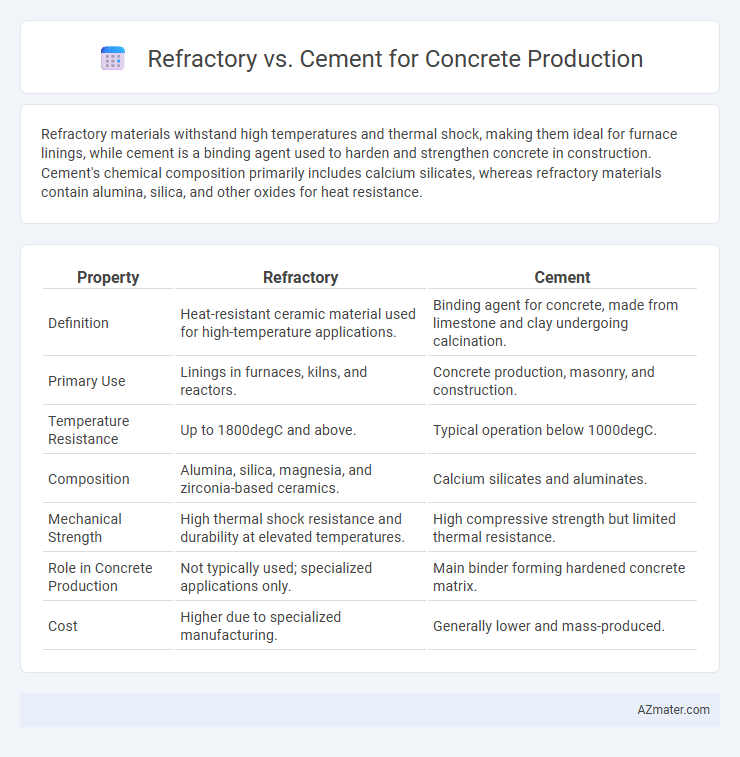Refractory materials withstand high temperatures and thermal shock, making them ideal for furnace linings, while cement is a binding agent used to harden and strengthen concrete in construction. Cement's chemical composition primarily includes calcium silicates, whereas refractory materials contain alumina, silica, and other oxides for heat resistance.
Table of Comparison
| Property | Refractory | Cement |
|---|---|---|
| Definition | Heat-resistant ceramic material used for high-temperature applications. | Binding agent for concrete, made from limestone and clay undergoing calcination. |
| Primary Use | Linings in furnaces, kilns, and reactors. | Concrete production, masonry, and construction. |
| Temperature Resistance | Up to 1800degC and above. | Typical operation below 1000degC. |
| Composition | Alumina, silica, magnesia, and zirconia-based ceramics. | Calcium silicates and aluminates. |
| Mechanical Strength | High thermal shock resistance and durability at elevated temperatures. | High compressive strength but limited thermal resistance. |
| Role in Concrete Production | Not typically used; specialized applications only. | Main binder forming hardened concrete matrix. |
| Cost | Higher due to specialized manufacturing. | Generally lower and mass-produced. |
Introduction to Concrete Production Materials
Refractory materials and cement play distinct roles in concrete production, with cement acting as the primary binding agent that hardens and binds aggregates to form concrete. Refractory materials, composed of heat-resistant minerals like alumina and silica, are specialized for applications requiring high thermal stability rather than structural binding. Understanding the chemical composition and thermal properties of these materials is crucial for selecting the right components based on the specific demands of concrete production, especially in environments exposed to extreme heat.
Understanding Refractory Materials
Refractory materials are specially designed to withstand extreme temperatures and chemical corrosion, making them essential for lining furnaces and kilns in concrete production. Unlike cement, which acts as a binder in concrete mixtures, refractories provide thermal stability and protect equipment from wear and thermal damage. Key refractory materials include firebricks, alumina, and silica-based compounds, which ensure durability and efficiency in high-heat environments during the cement manufacturing process.
What Is Cement? Types and Properties
Cement is a hydraulic binder primarily composed of clinker and gypsum, essential for concrete production due to its binding properties when mixed with water. Common types include Portland cement, known for its high strength and durability, and sulfate-resistant cement, which offers enhanced chemical resistance in aggressive environments. Its key properties include setting time, compressive strength, and heat of hydration, which influence the performance and longevity of concrete structures.
Key Differences Between Refractory and Cement
Refractory materials are designed to withstand extremely high temperatures and thermal stress, making them essential for lining furnaces, kilns, and reactors, whereas cement primarily acts as a binding agent in concrete to provide structural strength and durability. Refractory materials are composed of heat-resistant minerals like alumina and silica, while cement is typically made from clinker, gypsum, and various additives optimized for hydration and setting properties. The key difference lies in their functional properties: refractories excel in thermal resistance and insulation, whereas cement focuses on compressive strength and long-term stability in construction applications.
Roles of Refractory in Concrete Applications
Refractory materials play a critical role in concrete production by providing thermal insulation and resistance to high temperatures during the casting and curing processes, thereby preventing structural damage and ensuring durability. These materials protect concrete mixers, kilns, and other equipment from thermal shock and chemical corrosion, significantly extending their operational lifespan. Unlike cement, which primarily acts as a binding agent in concrete, refractories enhance thermal stability and performance under extreme heat conditions essential for specialized concrete applications.
Cement’s Function in Concrete Mixes
Cement acts as the primary binding agent in concrete mixes, facilitating the hydration process that hardens and strengthens the material. Unlike refractory materials designed to withstand extreme heat, cement provides structural integrity and durability essential for construction applications. Its chemical composition, primarily calcium silicates, ensures proper setting, cohesion, and long-term stability within concrete mixtures.
Performance Comparison: Refractory vs. Cement
Refractory materials provide superior heat resistance and thermal stability compared to conventional cement, making them ideal for high-temperature concrete production in industries like metallurgy and power generation. Cement offers excellent compressive strength and durability under normal environmental conditions but lacks the heat tolerance necessary for applications involving extreme thermal cycling. The choice between refractory and cement depends largely on the specific performance requirements, with refractory materials excelling in thermal performance and cement offering cost-effective structural integrity.
Cost Analysis: Refractory vs. Cement
Refractory materials typically incur higher upfront costs compared to standard cement due to their specialized composition and heat-resistant properties essential for high-temperature concrete applications. Cement, being widely produced and used, offers a cost-effective solution for general construction needs with lower raw material and production expenses. Evaluating total lifecycle costs, including maintenance and replacement frequency, reveals that refractory materials may offer better long-term value in industrial settings despite initial higher investment.
Choosing the Right Material for Your Concrete Project
Selecting refractory materials or cement for concrete production depends on the project's exposure to high temperatures and chemical resistance requirements. Refractory materials, composed of alumina, silica, and fireclay, offer superior heat resistance and durability in environments exceeding 1000degC, making them ideal for industrial furnaces and kilns. Cement-based concrete excels in structural strength and versatility for standard construction but lacks the thermal stability needed for high-temperature applications.
Conclusion: Optimizing Material Selection for Concrete Production
Optimizing material selection for concrete production requires evaluating the thermal resistance and durability of refractories versus the cost-effectiveness and ease of use of cement. Refractory materials provide superior performance in high-temperature environments, enhancing longevity in industrial applications, while cement remains the preferred choice for standard construction due to its affordability and versatility. Balancing these factors based on project requirements ensures optimal concrete performance and lifespan.

Infographic: Refractory vs Cement for Concrete Production
 azmater.com
azmater.com